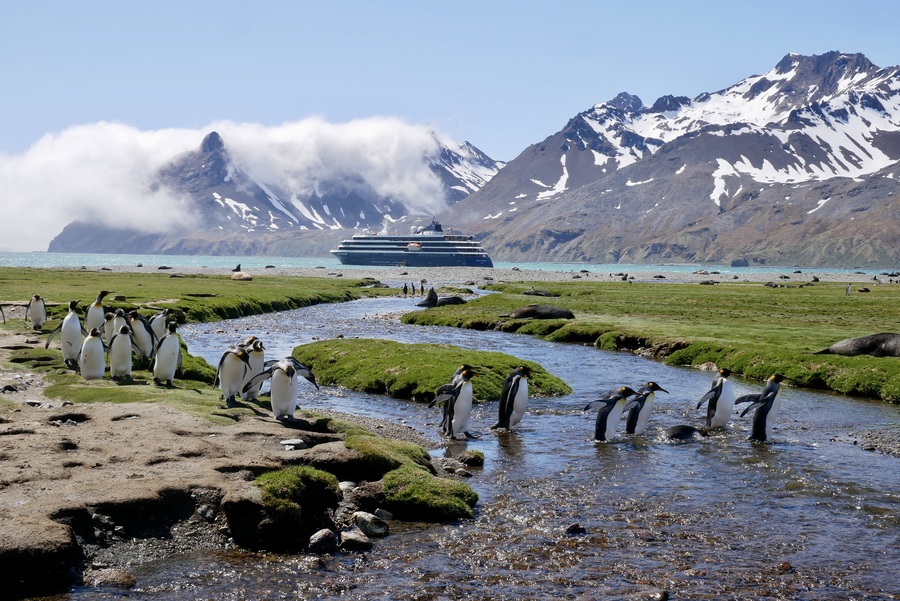
Among the Penguins of South Georgia Island
South Georgia Island is a place where the raw power of nature meets the unyielding tenacity of the human spirit.
A small speck of land in the vast Southern Ocean, it boasts towering peaks, swooping glaciers, and sprawling beaches strewn with wildlife. It is a place where jagged mountains crash into tumultuous ocean waves. A place where rusting machinery tells the story of a brutal, bygone industry. A place where few humans venture, yet where animals gather in the hundreds of thousands.
South Georgia Island: A Wild Frontier
The rugged, glacier-clad island of South Georgia stretches over 100 miles in length and less than 20 in width. A spine of craggy mountains runs across the length of the island, effectively cutting its northern reaches off from its southern shores.
Along its windswept beaches, penguin colonies congregate in the thousands. Elephant seals and fur seals fight for dominance over their territory. Seabirds build nests in the crevices of rocks, before setting off on their journeys across the open ocean.
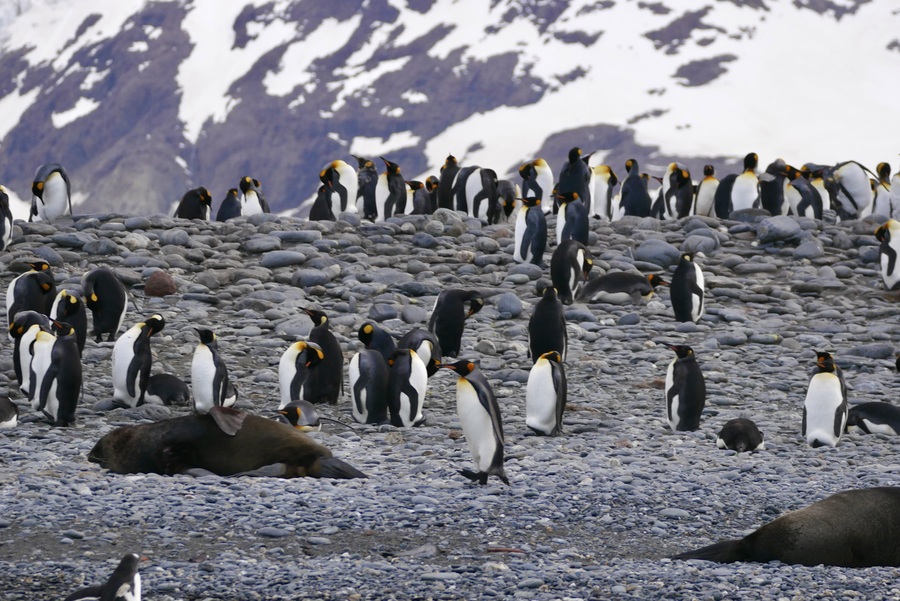
South Georgia is a place where few humans have ever ventured.
Yet, despite its isolation—sitting over 1,000 miles east of the South American landmass—South Georgia has played a pivotal role in stories of exploration, industry, and survival.
A Brief History of South Georgia
The history of South Georgia Island is inextricably intertwined with exploration, whaling, and scientific research. First sighted in 1675 by the English merchant Anthony de la Roché, it remained largely uncharted until the arrival of British explorer Captain James Cook a century later.
In 1775, James Cook landed on the island and formally claimed it for Britain, naming it “Isle of Georgia” in honor of King George III.
Apart from sealers, whalers, and researchers, South Georgia has remained uninhabited.
Whaling and Sealing in South Georgia
By the late 18th century, thanks to James Cook’s reports of the island’s abundant fur seal colonies, South Georgia became a hub for the sealing industry.
Seals were hunted aggressively for their pelts, which were highly valued in the global fur trade. Within a few decades, however, overhunting brought the animals to the brink of extinction. The plummeting seal population led hunters to turn elsewhere in search of pelts.
Following the industry’s decline and subsequent conservation efforts, South Georgia’s seal population has made a remarkable rebound.
Today, you’ll see thousands of elephant and fur seals lining the island’s beaches.
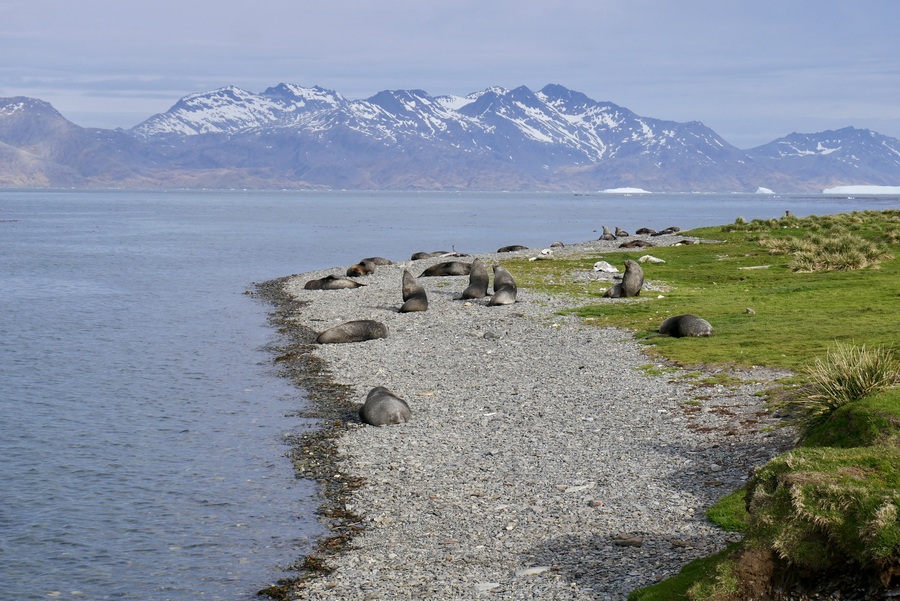
By the turn of the 20th century, a new industry landed on the island’s shores: whaling.
In 1904, Norwegian whaler Carl Anton Larsen established the first whaling station at Grytviken. Several other stations soon followed. The island quickly turned into one of the world’s most productive whaling sites, with thousands of blue, humpback, fin, and sperm whales harvested for their oil and blubber.
The industry peaked in the 1920s and 1930s, but—as with seals a century earlier—overexploitation led to severe declines in the whale population.
By the mid-20th century, as whale numbers plummeted and global attitudes toward conservation shifted, facilities began to shutter. In 1965, the last whaling station closed for good.
Today, the population of whales in South Georgia’s bays has rebounded, though the numbers are nowhere near their historical highs.
The Story of Ernest Shackleton
Ernest Shackleton’s remarkable story is one of courage and perseverance and survival. An Anglo-Irish explorer, Shackleton led the Imperial Trans-Antarctic Expedition in 1914, with the goal of completing the first land crossing in Antarctica.
While navigating the Weddell Sea, Shackleton’s ship, the Endurance, became trapped in fast-moving sea ice. Unable to dislodge the ship from the ice, Shackleton and his crew remained stranded. They withstood freezing temperatures and dwindling supplies for months.
The crew escaped their sinking ship by camping on sea ice until spring. Then, once temperatures began disintegrating the ice, the men loaded into lifeboats and set sail for Elephant Island.
From Elephant Island, Shackleton and five of his men set off in search of help. On a small boat called the James Caird, they battled the stormy waves of the southern Ocean for 17 days, before landing 800 miles away on the uninhabited shores of South Georgia.
Shackleton’s crew landed on the southern coast of the island and then proceeded to scale the sheer mountains (an impressive feat in and of itself), before securing assistance at the Stromness whaling station.
The remaining 23 crew—led by second-in-command Frank Wild—survived on Elephant Island for 4.5 months before their rescue.
Not a single person perished.
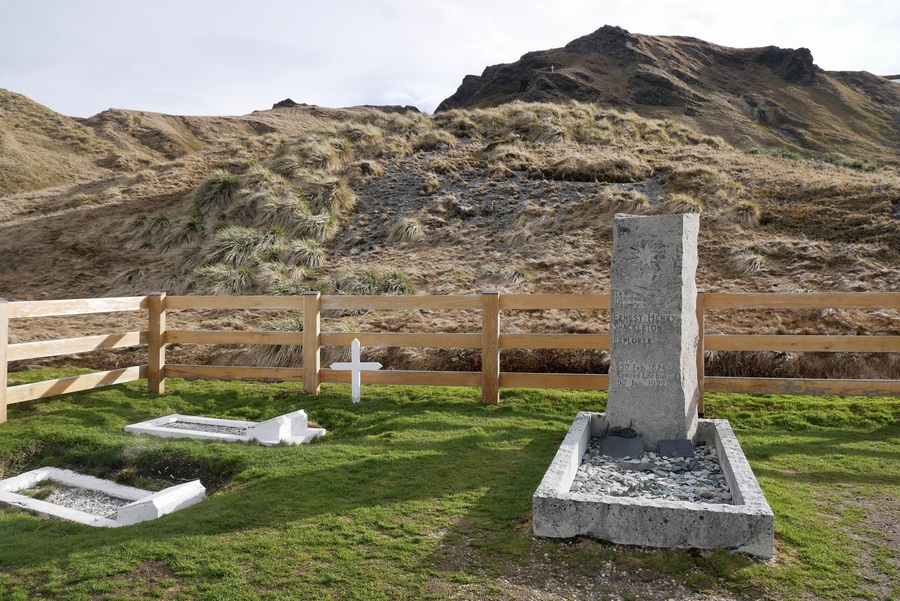
On a hill overlooking Grytvyken, the main “settlement” on South Georgia Island, you can find a small cemetery that houses the tombs of Sir Ernest Shackleton and his first mate, Frank Wild.
Cruising with Atlas Ocean Voyages
South Georgia Island has no commercial airports or transport services. To reach the island, you have to either join a research vessel, or set sail on an expedition cruise.
I traveled to South Georgia Island with the latter option, on a 14 day cruise with Atlas Ocean Voyages. Atlas is one of a handful of companies that travels to South Georgia. The company has four ships, each capable of carrying 200 passengers. Expeditions with Atlas include a roundtrip charter flight from Buenos Aires to Ushuaia, a day tour of Tierra del Fuego National Park, and all excursions while on board.
Our ship—the World Navigator—left Ushuaia and traveled the Southern Ocean to South Georgia, before heading to Antarctica for three days.
Our South Georgia Landings
Throughout our cruise, our expedition leaders reminded us that the area’s harsh conditions and ever-changing temperatures could cause sudden itinerary changes. They encouraged us to be flexible, to expect the unexpected, and to keep an open mind.
As a result of this challenging environment, Atlas’ sub-Antarctic expeditions do not have a set itinerary. Instead, the captain and crew bring passengers to the best available landing spots given weather conditions, ocean swells, and time constraints.
For us, weather was not a limiting factor in South Georgia. We experienced mostly clear skies and favorable conditions. But we did encounter an obstacle that we hadn’t foreseen: the bird flu.
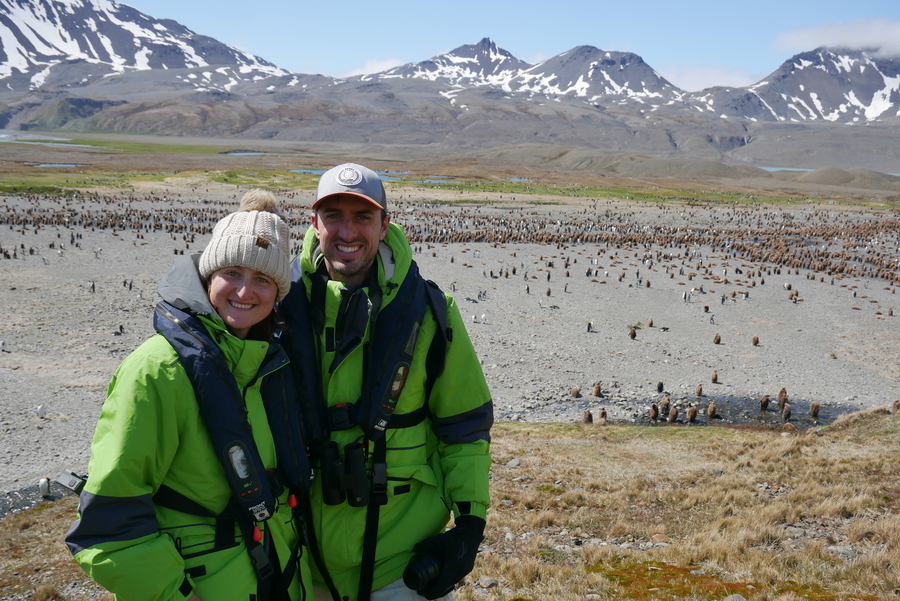
The bird flu reached South Georgia shortly before we did, affecting terns, brown skua, and fur seals.
Our expedition leaders, having been briefed on the rapidly-evolving crisis, would scope out landing spots before bringing passengers ashore. The scenes they witnessed were horrifying. They spoke of mangled seals littering the beaches, with their insides spilling into the sea. They spoke of birds in obvious distress, seizing and flailing and unable to fly.
The onset of the bird flu forced our expedition leaders to axe certain landing spots, both to spare us of the disturbing sights and to limit the virus spread.
Unfortunately, that meant that we had to skip St Andrews Bay—a famous location that houses more than 150,000 pairs of king penguins.
Regardless, the trip was exceptional. And each landing or zodiac excursion brought us face to face with some of nature’s most stunning wildlife displays.
Grytvyken
Grytviken is an important heritage site and a key stop on expedition cruises. It was our first landing site on South Georgia Island.
Founded by Norwegian whalers in the early 1900s, Grytvyken became one of the most important whaling hubs of the early 20th century. The site processed thousands of whales and is largely credited with the steep decline of whales in the Southern Ocean. The station remained active until the 1960s, when the whaling industry’s decline led to its abandonment.
The abandoned historic whaling station is the island’s administrative center and the hub of its limited tourist amenities (essentially just a small museum with a gift shop and post office). Aside from a few researchers and seasonal museum staff, Grytviken doesn’t have a permanent population.

We had roughly an hour to explore the museum, church, and cemetery of Grytvyken.
The small museum showcases the island’s history, from whaling to exploration. It is managed by the South Georgia Heritage Trust. Inside, you can find a replica of the James Caird.
A short walk away from the museum, lies the Grytvyken Cemetery. Among the graves of Norwegian whalers, you’ll find Shackleton’s tomb. It faces Antarctica and the tumultuous ocean he once explored.
Around Grytvyken, king penguins and fur seals mingle with the remnants of South Georgia’s past.
I spent an inordinate amount of time trying to photograph a small group of penguins that were hanging out near the cemetery.
If only I knew what the following days would bring.
Nordenskold Glacier
As we were traveling the rough seas en-route to South Georgia Island, our expedition leaders updated us with disappointing news. In an effort to curb the spread of the bird flu, landing sites were beginning to shut down one by one.
The staff, however, did a fabulous job ensuring that morale remained high. On the morning of our second day in South Georgia, our cruise director woke us up at 5:00am with a suggestion that we climb out of bed and head to the deck.
We heeded his advice. And then we gasped.
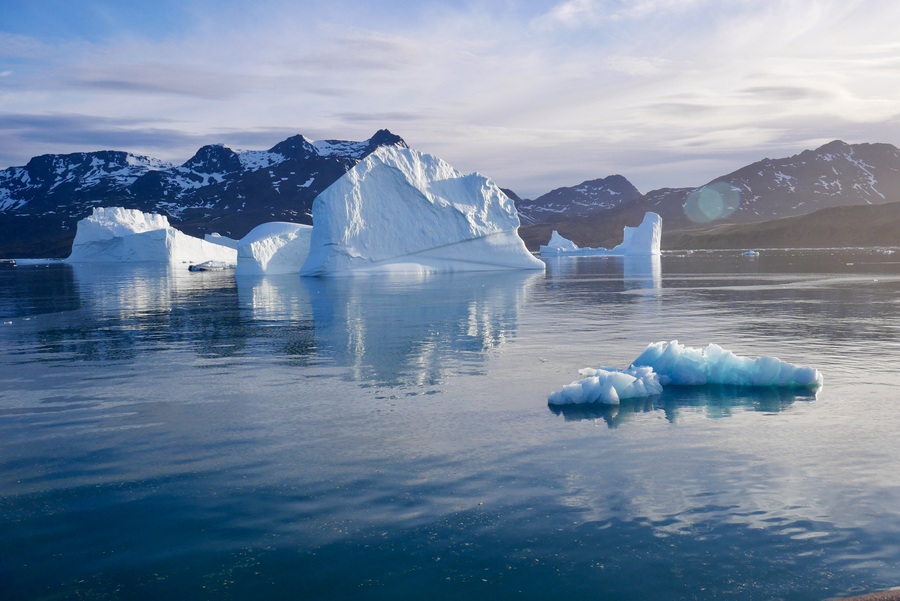
Early morning light cast a lilac glow over the serene waters of Cumberland East Bay. Stunning icebergs surrounded us, their reflections mirrored in the glassy water.
In front of us, the Nordenskjöld Glacier tumbled into the sea.
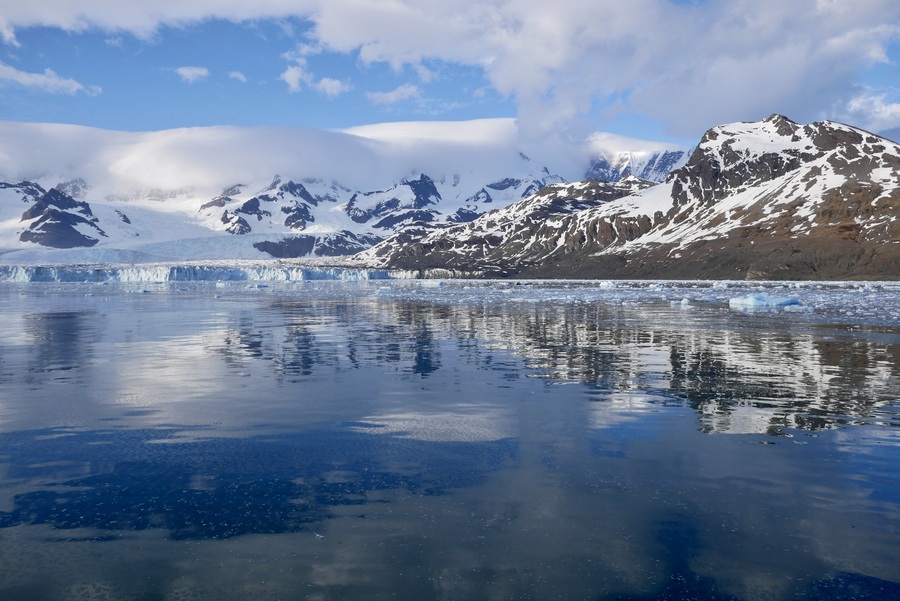
Immense glaciers cascading into the sea would become a common sight a few days later in Antarctica, but the Nordenskjöld Glacier was the first of our expedition.
And though I’d seen impressive glaciers before in Juneau Alaska and in Patagonia’s Los Glaciares National Park, the serene setting of South Georgia’s remote glacier still left me awestruck.
Godthul Bay Zodiac
The name “Godthul” means “Good Hollow” in Norwegian. The bay, situated on the northeastern coast of South Georgia Island, is surrounded by rugged mountains and home to diverse wildlife. Godthul Bay served as an important site for whaling activities in the early 20th century, with whalers using it as a base for processing operations. Today, rusting boats and pieces of machinery can still be found along the coastline.
Tucked among the billowing tussock grasses of Godthul, you’ll find tons of fur seals, elephant seals, and king penguins. The bay’s surrounding waters teem with marine life, and birds nest in the crevices of its coastal cliffs.

Our itinerary initially included a landing at Godthul, but when our expedition leaders scouted out conditions, they encountered aggressive fur seals that impeded our access to land. The seals hid amongst the grasses and blocked our path—essentially cutting us off from the area’s king penguin colony.
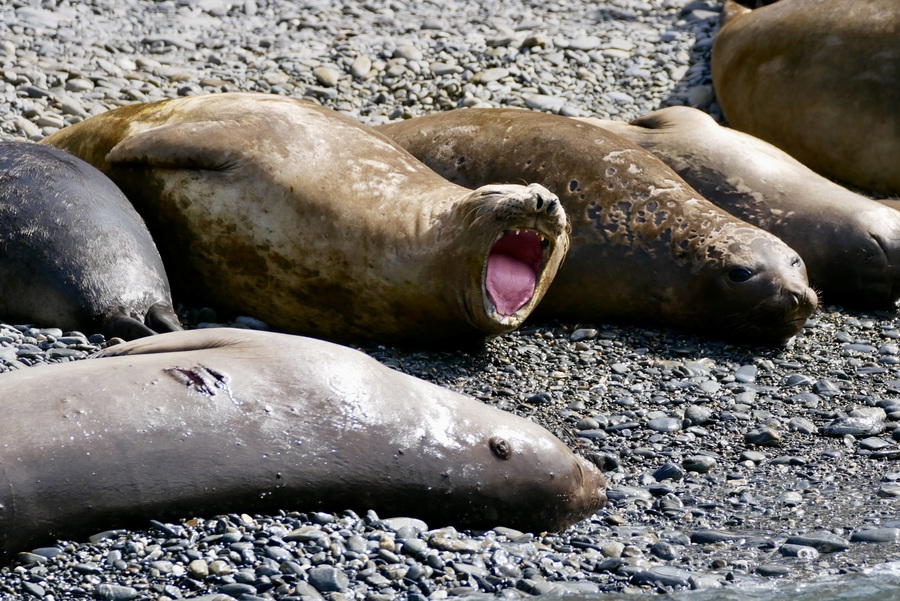
Instead of landing, our leaders made the executive decision to bring us around the area on zodiacs.
We cruised around the bay and admired the beautiful scenery, the nesting seabirds, the lounging seals, and a particularly playful penguin that was darting around our boat.
Ocean Harbour
Following our somewhat brief zodiac at Godthul, we had plans to visit Jason Harbour.
But before we reached the bay, we received notice that it, too, had been closed due to the bird flu.
The cruise staff quickly pivoted plans and brought us to Ocean Harbour instead.
As with our previous outing at Godthul, we encountered aggressive fur seals among Ocean Harbour’s tussock grasses.
This time, however, the crew decided to push forward with a shore excursion and led us on a scenic—albeit harrowing—walk around the area.
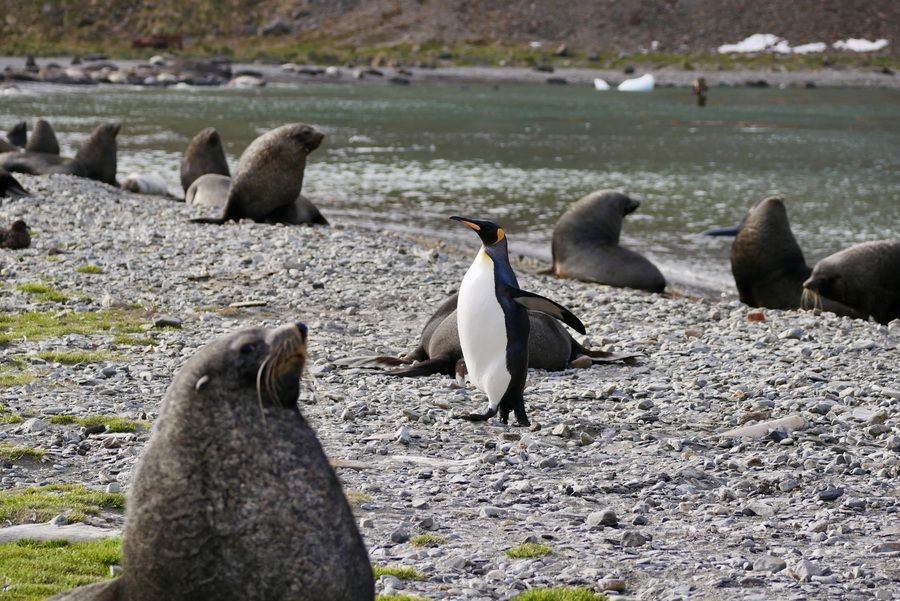
During our landing at Ocean Harbour, expedition guides led us in a small loop from our zodiacs to a small historic cemetery marked by simple white crosses.
The walk from the zodiacs to the cemetery is short—probably only a hundred yards or so—but it proved to be somewhat scary. To get anywhere beyond the beach meant passing by fur seals that lunged at us from behind the tussock grasses.
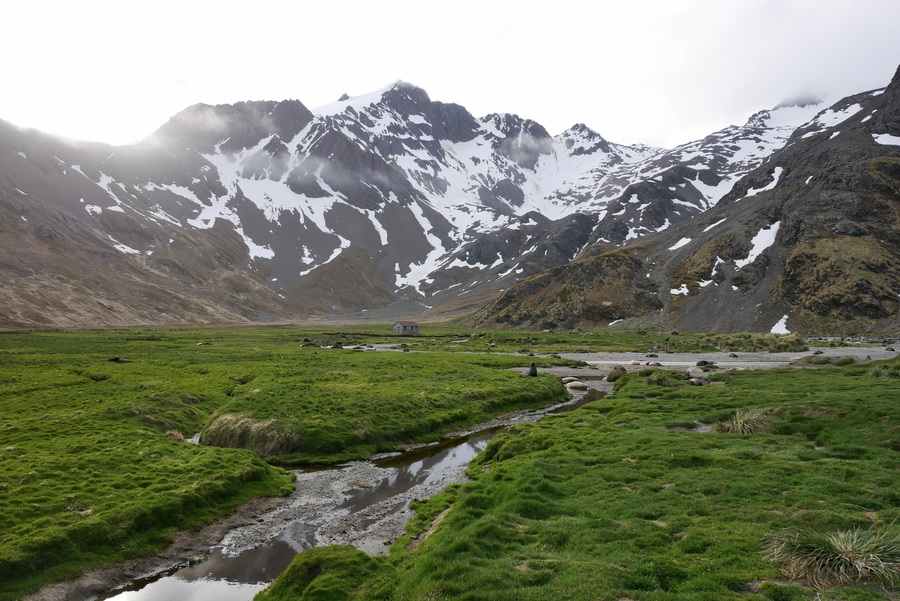
Once we got past the seals, however, we found ourselves in a lush field laced with streams, surrounded on three sides by South Georgia’s sheer mountains.
Formerly a whaling station in the early 20th century, Ocean Harbour now serves as a haven for diverse marine life.
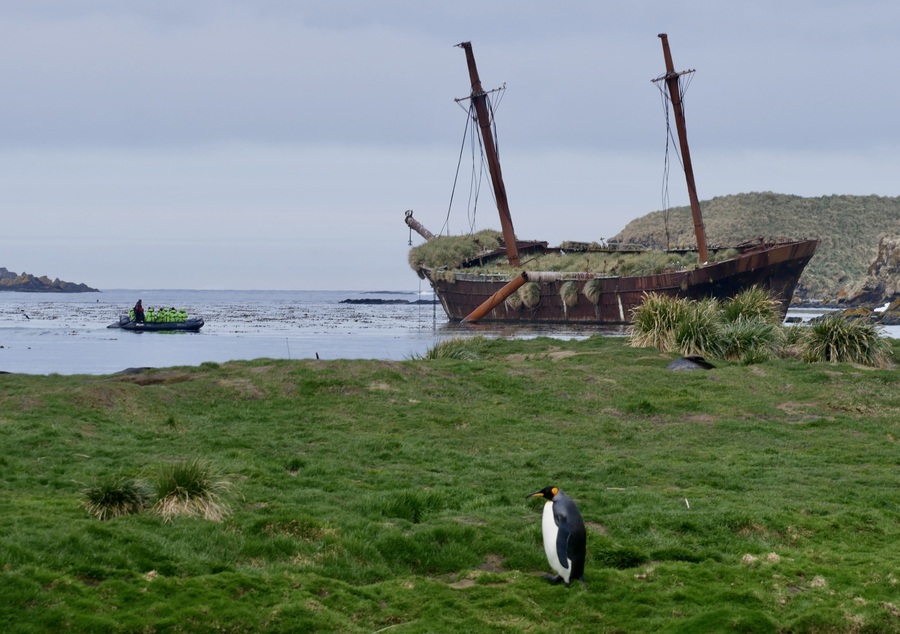
Today, tour boats and research vessels primarily visit Ocean Harbour for its rich biodiversity, but you can still find rusting remnants of whaling infrastructure littered about the area’s land and water.
Hercules Bay
On the morning of our second full day on South Georgia, we encountered calm seas and favorable weather. The ideal conditions allowed us to enter Hercules Bay for a zodiac cruise.
Up until that point on our cruise, we had encountered quite a few king penguins, but Hercules Bay would introduce us to two more varieties—macaroni penguins and gentoos.
Hercules Bay is home to a significant colony of macaroni penguins. These penguins get their name from the wispy yellow crests that adorn their heads.
I immediately assumed that the penguins were named for the spaghetti-like feathers above their eyes, but during our tour I learned that the name refers to 18th-century “macaroni” fashion. In the 1700s, the term “macaroni” was used to describe young British men who adopted extravagant clothing and hairstyles.

The scenery around Hercules Bay is among the most dramatic that we encountered on South Georgia. Soaring cliffs plunge into the sea. Waves crash onto rocky shores. A silvery waterfall cascades onto a pebbled beach that teems with wildlife.
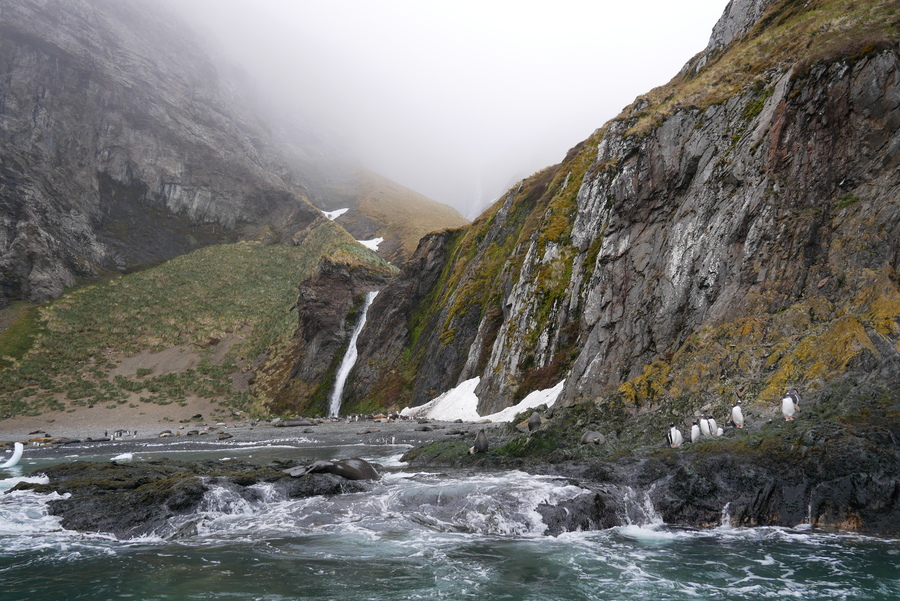
At Hercules Bay, we encountered fur seals engaging in battle, elephant seals lumbering over rocks, and beautiful blue-eyed shags nesting in the cliffs.
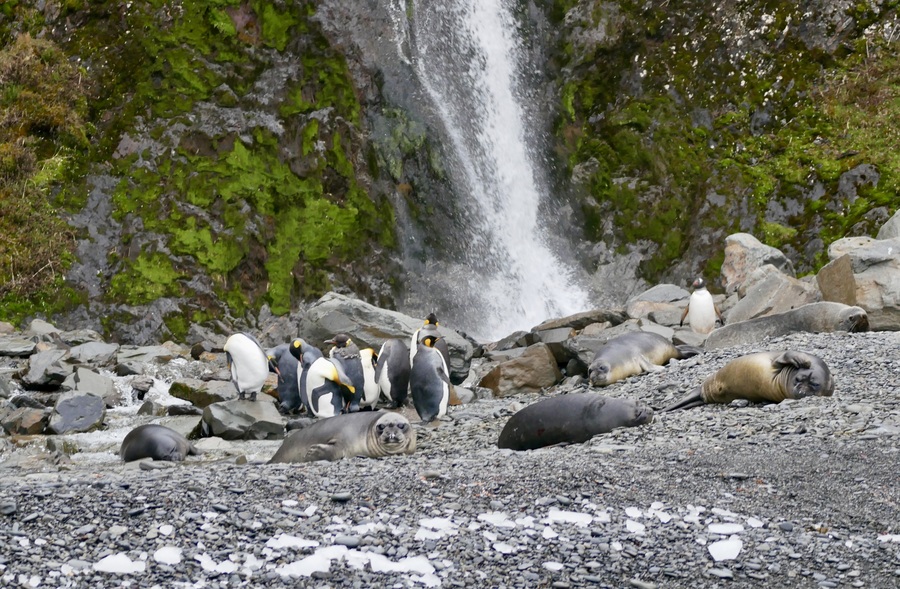
The entire cast of characters, set against a dramatic backdrop of soaring cliffs and pounding surf, made Hercules Bay a particularly memorable place to visit.
Fortuna Bay
I’m not sure I have the worlds to accurately describe what we encountered at Fortuna Bay.
The beautiful bay on South Georgia’s northern coast showcases some of the island’s best scenery and wildlife. The western shore is dominated by the jagged peaks of the Breakwind Ridge. A wide glacial outwash plain, laced by a network of criss-crossing streams, lies at the head of a fjord that leads to the Konig Glacier.
On the afternoon of our final day on South Georgia, we disembarked our zodiacs and set out in search of the area’s king penguin colony. Hundreds of fur seals and king penguins dotted the crescent of pebbled beach.
Behind us, we could see the turquoise water gently lapping against the rocks. In front of us, a green glacial plane adorned with braided streams led to a spectacular viewpoint.
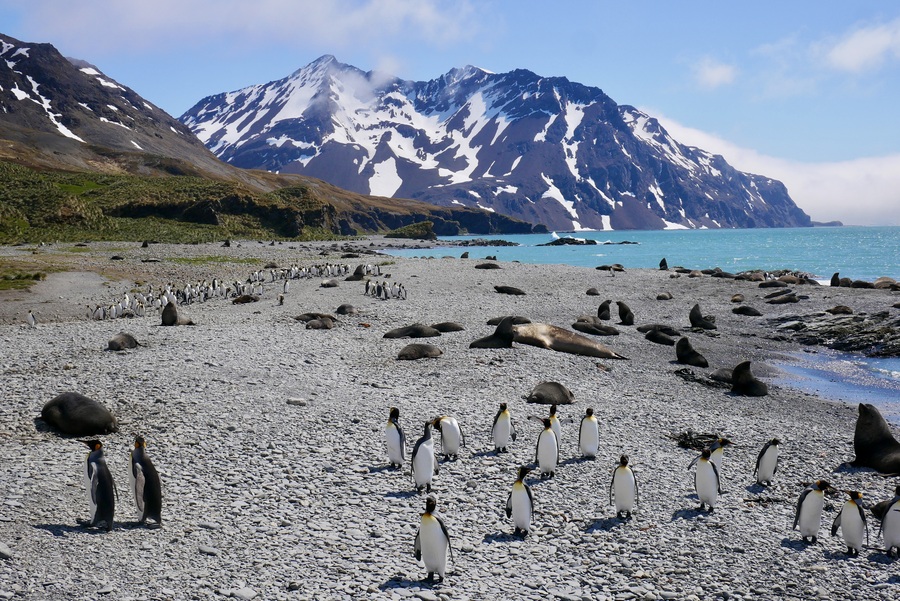
We hiked up a hill to the lookout area, encountering groups of penguins, waterfalls, and fur seals along the way.
When we reached the top of the bluff, we looked down at thousands of molting adolescent and adult penguins.
It was breathtaking.
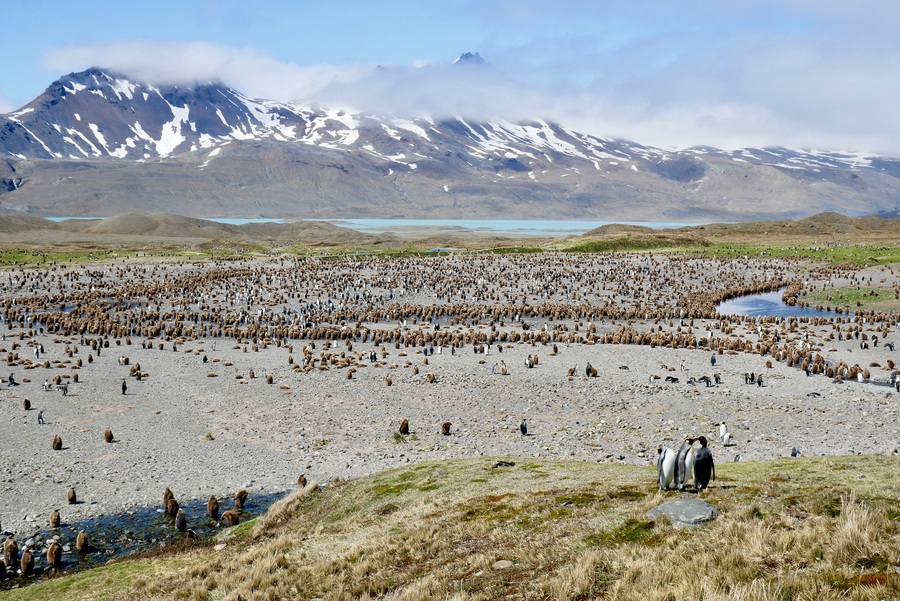
While Fortuna Bay isn’t the largest colony of penguins on South Georgia, it still hosts thousands of penguin pairs.
Sure, we were disappointed that we couldn’t see the 150,000 pair colony at St Andrews Bay, but we didn’t dwell on it for too long.
Our landing at Fortuna Bay was an awesome consolation prize.
Salisbury Plain
On our final day in South Georgia, favorable conditions allowed us to go on three excursions. Our final one, a zodiac at Salisbury Plain, brought us face to face with 60,000 breeding pairs of king penguins. It is the second largest colony of king penguins in South Georgia—home to roughly 250,000 individuals Including chicks and non-breeding adults.
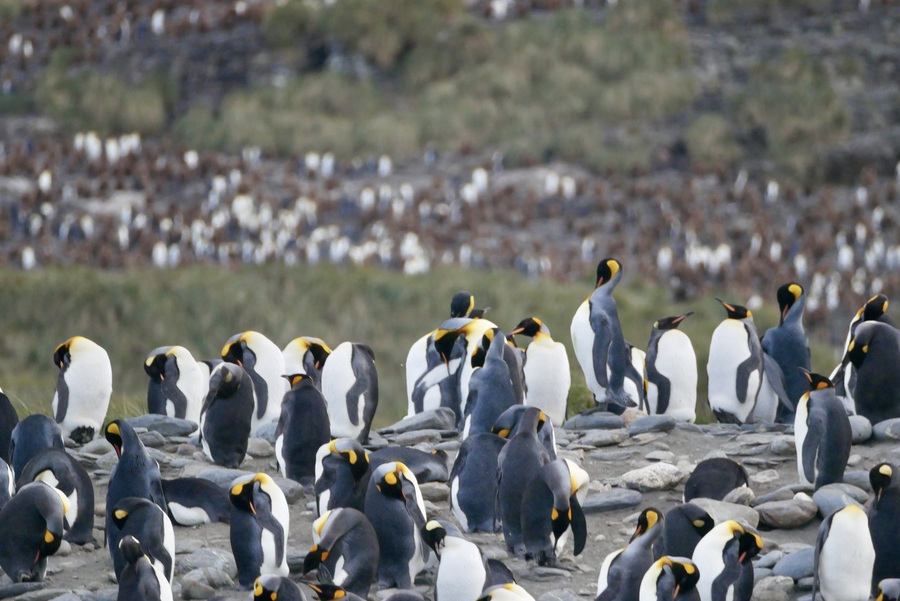
The sight of thousands of penguins densely packed along the shore is breathtaking to behold. I found myself continually focusing on individual penguins in the crowd, and then mentally zooming out to take in the scene as a whole.
It remains among the top three wildlife encounters of my life (my other two top experiences include swimming at Jellyfish Lake in Palau and admiring the Rietsfontein watering hole in Etosha).
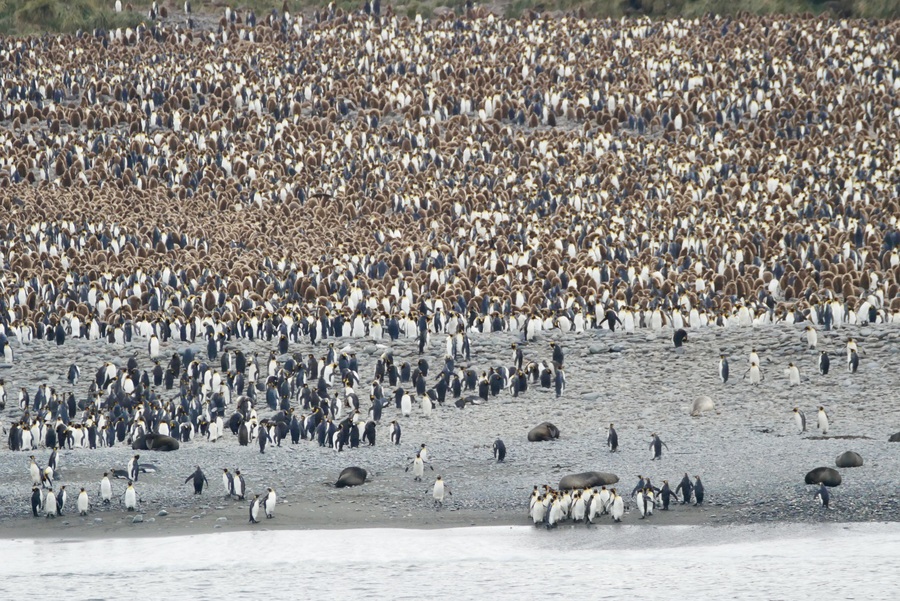
Due to the bird flu, we weren’t able to touch ground at Salisbury Plain, but a zodiac cruise of the shoreline was more than sufficient in showcasing one of the island’s largest penguin colonies.
From our zodiac, we photographed fur and elephant seals, stopped to watch a large group of giant petrels, followed porpoising penguins, and soaked in the dramatic mountain scenery.
Wildlife in South Georgia
South Georgia, sometimes referred to as the Serengeti of the Antarctic, hosts some of the most stunning wildlife displays on Earth.
Four types of penguins—kings, gentoos, chinstraps, and macaronis—can be found in large colonies throughout the island.
Penguins aren’t the only notable birds of South Georgia Island, though.
From massive wandering albatross (the largest of any bird) to the teeny tiny South Georgia pipit (a little brown songbird endemic to the island) the island’s avian life is quite diverse. You’ll likely spot giant petrels, beautiful blue eyed shags, brown skua, kelp gulls, and stunning black-and-white cape petrels.
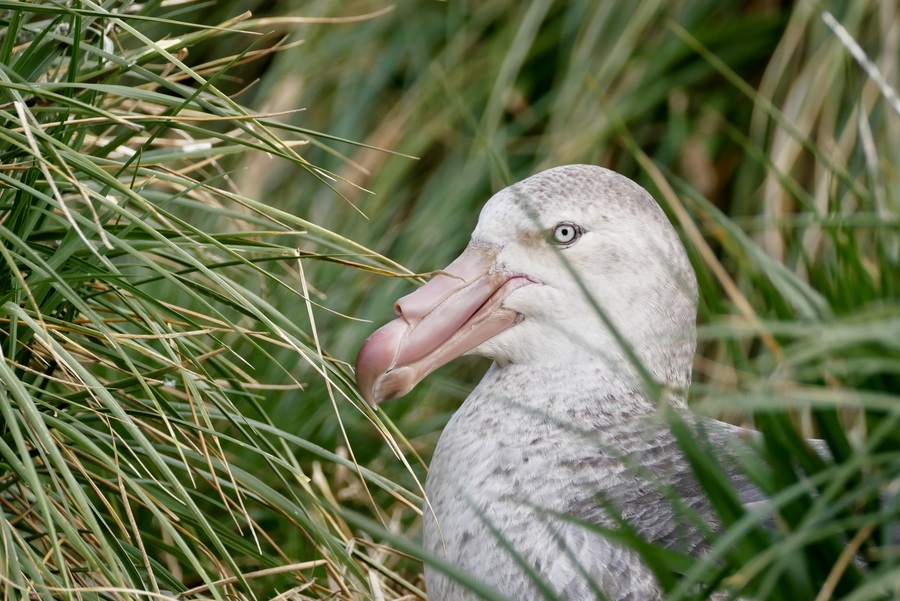
South Georgia is home to vast colonies of fur seals and elephant seals, both of which play a crucial role in the island’s dynamic ecosystem. You’re all but guaranteed to see thousands of seals on a trip to the island.
Fur seals often dart through the surf and lounge in groups along South Georgia’s beaches. During breeding season, dominant males, known as bulls, fiercely defend their harems, engaging in intense battles for territory and mates. They can be particularly dangerous if provoked.
In contrast, the massive southern elephant seals—the largest of all seals—seem somewhat more clunky in comparison. Male elephant seals can reach up to 20 feet in length and weigh several tons. During breeding season, they engage in violent clashes to establish dominance.
When to Visit South Georgia Island
Unless you’re a researcher, the only time you’ll be able to set foot on South Georgia Island is between November and March.
In November and December, at the start of the tourist season, you’ll encounter more snow and ice. At this time of year, peak breeding season means that the wildlife displays are at their most dramatic. The weather, however, can be a bit more unpredictable.
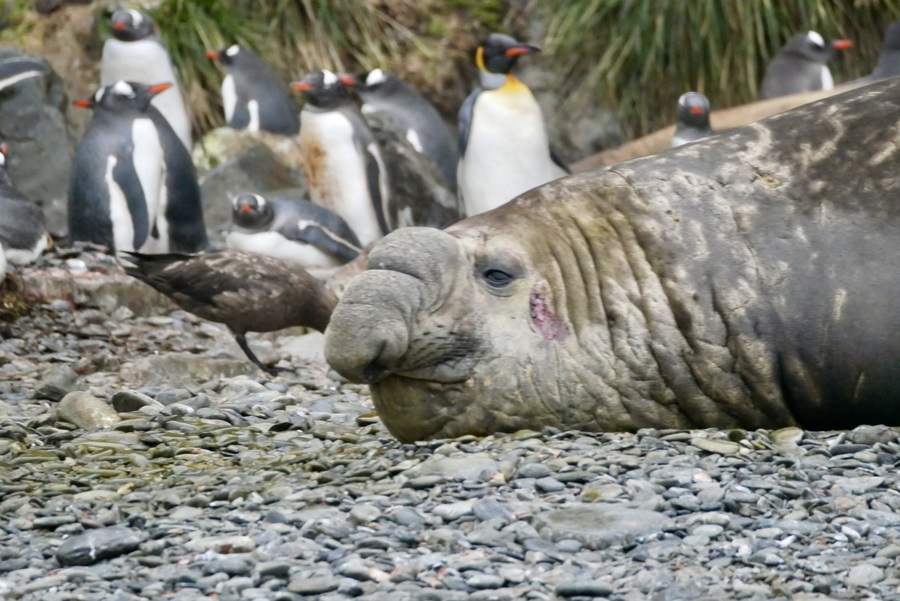
In January and February, temperatures are usually at their warmest and penguin chicks begin hatching. It is the most pleasant time of year to visit South Georgia Island.
March marks the end of tourist season on the island. You’ll still see plenty of wildlife (especially whales), though inclement weather can become more common.
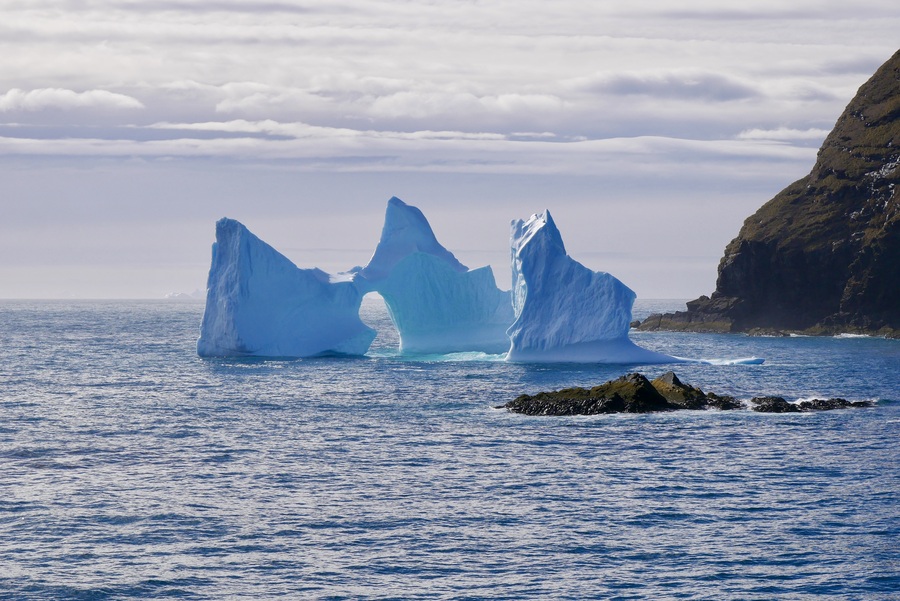
Between April and October, freezing temperatures and rough seas make South Georgia essentially unreachable.
We visited in November and lucked out with fantastic weather.
***
South Georgia’s history is a tale of human endurance in one of the most remote and inhospitable places on Earth.
Today, the island remains an untamed wilderness, a place where nature reigns supreme, and a remote outpost where only the hardiest explorers and conservationists venture.
South Georgia is a nature-lover’s dream.
It is a shining example of what I’ve always known to be true: that the farther you’re willing to travel, the greater the reward.

